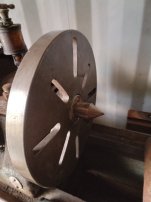My Monarch from the same time period and similarly sized has a Morse taper tailstock, but I’ve always felt the taper was recut and some of the face removed. The monarch spindle bore is just like your tailstock - a Jarno center fits much better, but it’s still sloppy at the outermost portion - maybe wear and tear since this lathe had a milling arbor without any means for a drawbar and it appears to have spun many times in its day. It would be handy if a MT 3-1/2 was a common size - I’ve always wondered why the dimensions jump so much from MT3 to 4?The tailstock taper is proving to be illusive. Morse #3 is too loose, Morse #4 only fits half way and feels like it's contacting more on the nose than the whole taper. B&S 9 is too loose, and B&S 10 fits halfway, but feels more solid than the Morse #4
How to install the app on iOS
Follow along with the video below to see how to install our site as a web app on your home screen.
Note: This feature may not be available in some browsers.
You are using an out of date browser. It may not display this or other websites correctly.
You should upgrade or use an alternative browser.
You should upgrade or use an alternative browser.
Flather & Co. Lathe
- Thread starter M.B. Naegle
- Start date
- Replies 33
- Views 2,550
M.B. Naegle
Diamond
- Joined
- Feb 7, 2011
- Location
- Conroe, TX USA
There really is no substitute for a lathe with birthing hips for ways! Im looking forward to putting this one through its paces. After its recent down time for repairs, I had a lot of fun with my old 16" Hendey seeing just how heavy it could cut. The old slow spindles on these lathes changes how fast you can work, but they'll peal the chips off if you let them.I have an old Monarch model A with a lead screw disconnect and it selects either the lead screw, “neutral” or the secondary drive keyed shaft that is belt driven off the 1:1 shaft, bypassing all gears but the reverse/forward tumblers. I just assumed normal turning would be done with the secondary shaft and bypass the change gears to save wear and tear, but now I’m wondering if there was another reason to disconnect the lead screw. Without any covering the lead screw does get a lot of chips - I wonder if it was kept disconnected to allow a simple fabric cover of some kind to rest on it.
Im impressed with how much heavier the castings are on your lathe compared to the early monarchs - and that taper attachment looks well thought out. Definitely a step up in overall beef and design. All early lathes look related - I bet old timers would say that about modern lathes. Lol
M.B. Naegle
Diamond
- Joined
- Feb 7, 2011
- Location
- Conroe, TX USA
Had some luck tonight!
I cleaned up the tail stock quill and found some gauling in the middle that was throwing off the prior tests. After cleaning the rust out I tried a Morse #4 again and it fit really close, so I used a Morse #4 reamer to clean off the gaulding inside and saw that it was making contact at various points along the whole taper. It could still use some doctoring, but I'm confident Morse #4 is the size. I took some measurements with an ID mic and did some calculating, and Morse was close, but none of the tapers matched exactly, likely due to the wear and my lack of proper taper measuring tools. There are fret marks on the quills OD where you can tell it's been clamped in a chuck several times, so I imagine the prior owners were using the taper attachment to clean up the quill taper, and it's possible it's a little off, but there's still enough meat to true it up later on. All and all, it's a common taper after all and will be easy to work with. It can share chucks and centers with the Hendey.
The tailstock hand wheel didn't look right to me being kinda thin and missing a ball crank. I pulled it off and found that under the paint there was "The Lunkenheimer Co. Cinc. Ohio" cast into the hub and "Open" with an arrow on the rim. Plumbing valve wheel! It was also too narrow so they used a sawed off piece of pipe and a washer as a spacer. A better wheel will be on my shopping list.
I also got the chuck broke free. Chain wrench around the cone pulley and a crowbar in the chuck pinned against the bed did the trick. It wasn't rusted on, but glued with dried oil and grime. The thread is a 2 1/4x8, which is the same as our South Bend 10L and some milling indexers, and I happen to have an extra back plate for a small 3 jaw chuck that I bought mistakenly as a 2 3/8x6 (I think the seller was measuring the thread minor diameter), I was too nice to try to return it, thinking I could turn it down to a 2 3/8, but now it has a home.
The spindle taper looks too be a #4 Morse as well, though it needs some cleaning to be sure. The spindle ID is a little over 1". Tiny for a lathe this size, but usable.
I cleaned up the tail stock quill and found some gauling in the middle that was throwing off the prior tests. After cleaning the rust out I tried a Morse #4 again and it fit really close, so I used a Morse #4 reamer to clean off the gaulding inside and saw that it was making contact at various points along the whole taper. It could still use some doctoring, but I'm confident Morse #4 is the size. I took some measurements with an ID mic and did some calculating, and Morse was close, but none of the tapers matched exactly, likely due to the wear and my lack of proper taper measuring tools. There are fret marks on the quills OD where you can tell it's been clamped in a chuck several times, so I imagine the prior owners were using the taper attachment to clean up the quill taper, and it's possible it's a little off, but there's still enough meat to true it up later on. All and all, it's a common taper after all and will be easy to work with. It can share chucks and centers with the Hendey.
The tailstock hand wheel didn't look right to me being kinda thin and missing a ball crank. I pulled it off and found that under the paint there was "The Lunkenheimer Co. Cinc. Ohio" cast into the hub and "Open" with an arrow on the rim. Plumbing valve wheel! It was also too narrow so they used a sawed off piece of pipe and a washer as a spacer. A better wheel will be on my shopping list.
I also got the chuck broke free. Chain wrench around the cone pulley and a crowbar in the chuck pinned against the bed did the trick. It wasn't rusted on, but glued with dried oil and grime. The thread is a 2 1/4x8, which is the same as our South Bend 10L and some milling indexers, and I happen to have an extra back plate for a small 3 jaw chuck that I bought mistakenly as a 2 3/8x6 (I think the seller was measuring the thread minor diameter), I was too nice to try to return it, thinking I could turn it down to a 2 3/8, but now it has a home.
The spindle taper looks too be a #4 Morse as well, though it needs some cleaning to be sure. The spindle ID is a little over 1". Tiny for a lathe this size, but usable.
Last edited:
M.B. Naegle
Diamond
- Joined
- Feb 7, 2011
- Location
- Conroe, TX USA
More work holding thoughts: After some more digging, I found a new/old 8" chuck plate (no holes) from our South Bend that I think will serve the Flather better. One issue I found with the back plate I mentioned previously (which is a 6") is that while being the same thread, the Flather has a longer threaded nose than the South Bend, and when I thread on the 6" plate the nose projects past the plate about 1/2". I'll likely make a hardened ground spacer to rectify this as I like having the option of sharing chucks between machines, but the 6" plate will end up on the South Bend I think, and I'll be in the market for an 8" 3-jaw for the Flather.
I also gathered up what we had for larger drive dogs to see how big of a plate I would need to utilize them. a 10" driving plate would be ideal, but most I see for sale (in the 2 1/4x8 thread) are 5" up to 8". If anyone has a 10"+ diameter between-centers driving plate available, let me know. Same for my Hendey as well, which would be a 2 3/8x6 by 10"+ diameter.
Sloted plates are another option I want to have for both these lathes, and IMO it's best to have a slot plate that makes full use of your swing so you have the area for clamps and what not. So if anyone has a 2 1/4x8 that's between 12" and 14" diameter, or a 2 3/8x6 between 14" and 16", I'm interested.
Somewhere I have an extra 5C collet nose, the kind you use a T wrench to open/close, which I was going to put on a threaded plate for the Hendey, but now that the Hendey has it's original 3H collet closer sorted out, I think that 5C nose will go towards this Flather. 5C would be a good fit for the 1" spindle bore, and the lack of a draw tube on that closer helps too. I gotta see where I put it, but I think it's a 4" or 5" diameter, and if a ready-to-go back plate isn't available, I have some small diameter iron hub castings that would turn into a back plate easily.
I'll likely post a classified for this stuff, as well as keeping an eye on the Bay.
I'll also add too that the miss-matched tail stock wheel is most likely because it was pushed off the end of the bed at some point. That happened to one of our other lathes once, and after we brazed the broken wheel back together, we threaded a bolt into the end of the bed for the tail stock to slide up against and I've added this feature to a few other lathes too. There's a couple of threaded holes in the end of the Flather's bed as well and I assume this was their purpose.
I also gathered up what we had for larger drive dogs to see how big of a plate I would need to utilize them. a 10" driving plate would be ideal, but most I see for sale (in the 2 1/4x8 thread) are 5" up to 8". If anyone has a 10"+ diameter between-centers driving plate available, let me know. Same for my Hendey as well, which would be a 2 3/8x6 by 10"+ diameter.
Sloted plates are another option I want to have for both these lathes, and IMO it's best to have a slot plate that makes full use of your swing so you have the area for clamps and what not. So if anyone has a 2 1/4x8 that's between 12" and 14" diameter, or a 2 3/8x6 between 14" and 16", I'm interested.
Somewhere I have an extra 5C collet nose, the kind you use a T wrench to open/close, which I was going to put on a threaded plate for the Hendey, but now that the Hendey has it's original 3H collet closer sorted out, I think that 5C nose will go towards this Flather. 5C would be a good fit for the 1" spindle bore, and the lack of a draw tube on that closer helps too. I gotta see where I put it, but I think it's a 4" or 5" diameter, and if a ready-to-go back plate isn't available, I have some small diameter iron hub castings that would turn into a back plate easily.
I'll likely post a classified for this stuff, as well as keeping an eye on the Bay.
I'll also add too that the miss-matched tail stock wheel is most likely because it was pushed off the end of the bed at some point. That happened to one of our other lathes once, and after we brazed the broken wheel back together, we threaded a bolt into the end of the bed for the tail stock to slide up against and I've added this feature to a few other lathes too. There's a couple of threaded holes in the end of the Flather's bed as well and I assume this was their purpose.
Joe in NH
Diamond
- Joined
- Jul 28, 2007
- Location
- Stratham, Cow Hampshire
My "kissing cousin" sister to this Flather was No. 715 IIRC. I can't tell you if that is the serial number of that "model" - or the total production of Flather up to that time.
The 715 was on the "far end top" of the cross slide/saddle dovetail - opposite from where the cross shaft enters the saddle.
With the motor pillar, a drive-all and a three phase motor (replaced by me with a reversing single phase for use at the house) the lathe weighed 1450lbs. This to be brought home in my 1/2 ton "LUV" Chevrolet Pickup. I didn't remove the legs and it stood on wooden stretchers and while held in to the bed securely with ratchet straps, it presented a rather "top heavy" appearance to that small truck. Not to mention overloaded. I was very careful to drive home at no more than 30mph - which made for a long trip down Route 20 south of Worcester, MA - but I did make it without issue - or the attention of the Police. I could tell other drivers were "wary" of my load though.
I used the Flather for about 10 years but sold it for what I had in it to a neighbor's friend in Manchester, NH. He later moved to Nashua.
IIRC the Taper on that both head and tail was a MT3.
It was a very "sturdy" lathe that one could use carbide tooling on without issue - except for the speed which was all "high speed" adapted and considerably slower.
Joe in NH
The 715 was on the "far end top" of the cross slide/saddle dovetail - opposite from where the cross shaft enters the saddle.
With the motor pillar, a drive-all and a three phase motor (replaced by me with a reversing single phase for use at the house) the lathe weighed 1450lbs. This to be brought home in my 1/2 ton "LUV" Chevrolet Pickup. I didn't remove the legs and it stood on wooden stretchers and while held in to the bed securely with ratchet straps, it presented a rather "top heavy" appearance to that small truck. Not to mention overloaded. I was very careful to drive home at no more than 30mph - which made for a long trip down Route 20 south of Worcester, MA - but I did make it without issue - or the attention of the Police. I could tell other drivers were "wary" of my load though.
I used the Flather for about 10 years but sold it for what I had in it to a neighbor's friend in Manchester, NH. He later moved to Nashua.
IIRC the Taper on that both head and tail was a MT3.
It was a very "sturdy" lathe that one could use carbide tooling on without issue - except for the speed which was all "high speed" adapted and considerably slower.
Joe in NH
M.B. Naegle
Diamond
- Joined
- Feb 7, 2011
- Location
- Conroe, TX USA
Found the serial number under the taper attachment portion of the cross slide. 01495. Confirmed as it's stamped under the spindle bearing caps.

They had a piece of canvas to catch chips between the two halves of the cross slide. Functional, but dosn't seem ideal or original. There's a recess in the top of the saddle over the compound screw like it might have had some kind of telescoping cover, or maybe there was a tin cover over the top. Whatever it had, it needs to allow access to a stop rod between the two. The taper attachment design is such that you don't need to disengage the cross slide from the taper attachment to use it. The two movements work independently of each other, unlike on other lathes where you need to unclamp or somehow disconnect the cross slide from the nut and screw to use the taper attachment. On my Hendey for example, the screw, nut, ball crank, and rear bearing move with the cross slide when the taper attachment is in motion, but you have to clamp the rear bearing to the saddle to use the compound conventionally.

Also pulled off the tool post and the riser they made for it. It'll be handy for heavy turning, but I do want to find a legitimate compound. I'll need one with a 7" diameter base, has a 1 5/8" pilot, and 1/2" mounting bolts about 5 1/2" apart.
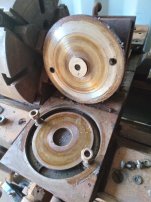
The current tail stock hand wheel.
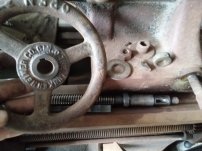
The carriage hand wheel was also replaced with a plumbing valve wheel, this one made by the Crane Co. It started life with a square hole drilled to 5/8" and a keyway broached in one corner, a ball crank brazed into a spokes corner, and washers and little bits of brass shim stock to make it all fit tighter. I have one extra hand wheel that will make a good replacement for one of these missing wheels. It's only 6.5" across, but has more mass and a better shape.

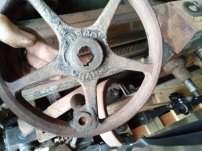

The outer spindle bearing looks plenty usable. The adjusting nuts around the mounting bolts make it so there's no need to shim the caps. I'm happy to be seeing as much oil between parts. It looks like this lathe stayed indoors, with the rust only being from humidity.
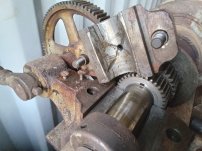
Here's the virgin 8" backplate and a center fitting nicely in the spindle. I have another stubby #4 center that I'm going to see if will fit deeper into the spindle.
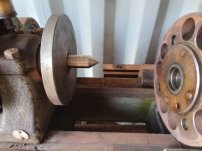

They had a piece of canvas to catch chips between the two halves of the cross slide. Functional, but dosn't seem ideal or original. There's a recess in the top of the saddle over the compound screw like it might have had some kind of telescoping cover, or maybe there was a tin cover over the top. Whatever it had, it needs to allow access to a stop rod between the two. The taper attachment design is such that you don't need to disengage the cross slide from the taper attachment to use it. The two movements work independently of each other, unlike on other lathes where you need to unclamp or somehow disconnect the cross slide from the nut and screw to use the taper attachment. On my Hendey for example, the screw, nut, ball crank, and rear bearing move with the cross slide when the taper attachment is in motion, but you have to clamp the rear bearing to the saddle to use the compound conventionally.

Also pulled off the tool post and the riser they made for it. It'll be handy for heavy turning, but I do want to find a legitimate compound. I'll need one with a 7" diameter base, has a 1 5/8" pilot, and 1/2" mounting bolts about 5 1/2" apart.

The current tail stock hand wheel.

The carriage hand wheel was also replaced with a plumbing valve wheel, this one made by the Crane Co. It started life with a square hole drilled to 5/8" and a keyway broached in one corner, a ball crank brazed into a spokes corner, and washers and little bits of brass shim stock to make it all fit tighter. I have one extra hand wheel that will make a good replacement for one of these missing wheels. It's only 6.5" across, but has more mass and a better shape.



The outer spindle bearing looks plenty usable. The adjusting nuts around the mounting bolts make it so there's no need to shim the caps. I'm happy to be seeing as much oil between parts. It looks like this lathe stayed indoors, with the rust only being from humidity.

Here's the virgin 8" backplate and a center fitting nicely in the spindle. I have another stubby #4 center that I'm going to see if will fit deeper into the spindle.

Last edited:
M.B. Naegle
Diamond
- Joined
- Feb 7, 2011
- Location
- Conroe, TX USA
Also, in case someone just has one lying around ! The upper cone pulley I'm looking for is a 4 step pulley with a 1 3/16" difference between each step. The lower diameters are 9 1/8", 7 1/4", 5 3/8", and 3 1/2". The upper cone wouldn't need to match exactly, but needs that 1 3/16" step difference to keep the same belt length/tension. The steps are 2 5/8" wide as well (2 1/2" belt?) making the pulley at least 10 1/2" wide. So unless I'm super lucky, I'll be adding this pulley to my list of cones to weld together from pipe and disc drops, or I'll glue it up out of hard maple like I did for the WB lathe.
! The upper cone pulley I'm looking for is a 4 step pulley with a 1 3/16" difference between each step. The lower diameters are 9 1/8", 7 1/4", 5 3/8", and 3 1/2". The upper cone wouldn't need to match exactly, but needs that 1 3/16" step difference to keep the same belt length/tension. The steps are 2 5/8" wide as well (2 1/2" belt?) making the pulley at least 10 1/2" wide. So unless I'm super lucky, I'll be adding this pulley to my list of cones to weld together from pipe and disc drops, or I'll glue it up out of hard maple like I did for the WB lathe.
On Edit: mis-read my paper napkin math: it's a 1 7/8" difference between each step, not 1 3/16".
 ! The upper cone pulley I'm looking for is a 4 step pulley with a 1 3/16" difference between each step. The lower diameters are 9 1/8", 7 1/4", 5 3/8", and 3 1/2". The upper cone wouldn't need to match exactly, but needs that 1 3/16" step difference to keep the same belt length/tension. The steps are 2 5/8" wide as well (2 1/2" belt?) making the pulley at least 10 1/2" wide. So unless I'm super lucky, I'll be adding this pulley to my list of cones to weld together from pipe and disc drops, or I'll glue it up out of hard maple like I did for the WB lathe.
! The upper cone pulley I'm looking for is a 4 step pulley with a 1 3/16" difference between each step. The lower diameters are 9 1/8", 7 1/4", 5 3/8", and 3 1/2". The upper cone wouldn't need to match exactly, but needs that 1 3/16" step difference to keep the same belt length/tension. The steps are 2 5/8" wide as well (2 1/2" belt?) making the pulley at least 10 1/2" wide. So unless I'm super lucky, I'll be adding this pulley to my list of cones to weld together from pipe and disc drops, or I'll glue it up out of hard maple like I did for the WB lathe.On Edit: mis-read my paper napkin math: it's a 1 7/8" difference between each step, not 1 3/16".
Last edited:
M.B. Naegle
Diamond
- Joined
- Feb 7, 2011
- Location
- Conroe, TX USA
Big thanks to Derek Smalls as he had a steady rest, tail stock clamp with bolts, and tail stock handwheel rescued from an earlier Flather. Everything fit perfectly, looks and functions better than the shop made pieces I had. The steady rests casting are a perfect complement to the headstock.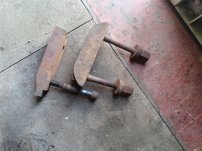

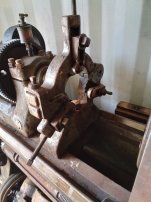
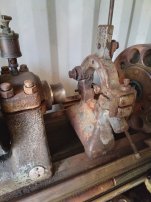
Paint Colors (very important in order to maintain machine accuracy, I know). Originally everything was Black and had one or two coats of grey over that, but it looks like someone painted some of the guards red too. As I get things cleaned and refinished, I want to go back to black. I like sticking with Black's and Greys to allow the irons aesthetics to stand out, but I'm starting to think red handwheels and handles would accent it well, especially with the polished apron front.
I'm also thinking about the best way to redo the name plate on the QC gearbox. It's brass and would look nice with some polishing, but the embossing is fairly shallow so I want to avoid losing too much definition with it. It would be nice to give the plate a black background, but I think the lack of definition would make it almost impossible to fill the background with paint. I'll likely just have to bite the bullet and polish it, but give it a good coat of lacquer to keep it from tarnishing necessitating any future polishing. I could have a new plate made with the black background, but I wouldn't want to replace the original one unless I had to.




Paint Colors (very important in order to maintain machine accuracy, I know). Originally everything was Black and had one or two coats of grey over that, but it looks like someone painted some of the guards red too. As I get things cleaned and refinished, I want to go back to black. I like sticking with Black's and Greys to allow the irons aesthetics to stand out, but I'm starting to think red handwheels and handles would accent it well, especially with the polished apron front.
I'm also thinking about the best way to redo the name plate on the QC gearbox. It's brass and would look nice with some polishing, but the embossing is fairly shallow so I want to avoid losing too much definition with it. It would be nice to give the plate a black background, but I think the lack of definition would make it almost impossible to fill the background with paint. I'll likely just have to bite the bullet and polish it, but give it a good coat of lacquer to keep it from tarnishing necessitating any future polishing. I could have a new plate made with the black background, but I wouldn't want to replace the original one unless I had to.
Last edited:
M.B. Naegle
Diamond
- Joined
- Feb 7, 2011
- Location
- Conroe, TX USA
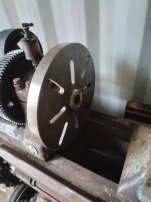
I also located a 10" slot plate for the Flather, though it has the same register spacing issue mentioned before, so a spacer will be nessisary. Still hoping for a 10" driving plate eventually, particularly for its wider slot cut through the end, but this one can serve for that purpose too in the short term. I know I can also do the trick of turning a center in a chuck and using that to drive between centers, but I like having more bed space and work visibility if I have a part between centers.
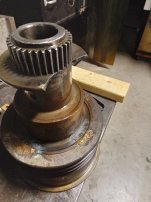
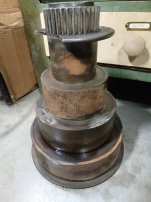
I also got the V pulley cut away from the Headstock Cone. It had a few 1" brazing beads holding it on. Cleaning those up will leave some superficial scars, but otherwise the original flat belt steps are intact and unaffected. The broken rim on the small end has a couple splashes of brazing on it like it had been brazed back together in the past, but the broken piece is gone so I'll make a patch out of some mild steel and braze it on again. I suppose it offers some guidance to the belt, but I think it's main purpose Is to keep the gear oil away from the belt and with the gear guard it closes in the pinch point there.
Also, with a recent donation from John Oder (Thanks!) I have the 4 pipe sections to make a welded upper pulley with the same diameters as the Headstock pulley. Putting reason to providence, an upper cone pulley with more mass could play into the heavier turning the Flather could see. I'll start on that once I have some other fab part projects moving along.
Last edited:
M.B. Naegle
Diamond
- Joined
- Feb 7, 2011
- Location
- Conroe, TX USA
I found a center that better fits both the headstock and the tailstock. As far as I can tell it's the same #4 Morse taper, but it's shorter overall by about an inch with the taper being on the smaller end of the spectrum, so it fits with less projection. Is there a name for such, other than a "stubby" #4 Morse? I don't think it's a Morse #4 1/2 as I have a couple collet noses in that taper that didn't fit. It doesn't look particularly old and looks factory made. I only have one, but I can work with the full size #4 in the tailstock and just use this one in the headstock so that the dogs can reach the driving plate. If they're out there though, it would be handy to know what to looks for, or if there's standard dimensions to follow it would help when I make my own.
johnoder
Diamond
- Joined
- Jul 16, 2004
- Location
- Houston, TX USA
Here are the various standard tapers that may be of some use - no doubt later than the practice when the lathe was made - which seems to be non standardI found a center that better fits both the headstock and the tailstock. As far as I can tell it's the same #4 Morse taper, but it's shorter overall by about an inch with the taper being on the smaller end of the spectrum, so it fits with less projection. Is there a name for such, other than a "stubby" #4 Morse? I don't think it's a Morse #4 1/2 as I have a couple collet noses in that taper that didn't fit. It doesn't look particularly old and looks factory made. I only have one, but I can work with the full size #4 in the tailstock and just use this one in the headstock so that the dogs can reach the driving plate. If they're out there though, it would be handy to know what to looks for, or if there's standard dimensions to follow it would help when I make my own.

I see the Flather has a little write-up in the book Lathe Design, Construction and Operation from 1916 if you happen to run across that reprint by Lindsay. It starts on page 292
Last edited:
M.B. Naegle
Diamond
- Joined
- Feb 7, 2011
- Location
- Conroe, TX USA
M.B. Naegle
Diamond
- Joined
- Feb 7, 2011
- Location
- Conroe, TX USA
A new piece came in today for this lathe. It was a bit of a frivolous purchase, costing a little more than it was really worth, but one of those things you'll likely never find again.
Double end wrench with 'Flather Nashua N.H.' stamped into it, and sized to fit several adjusting bolts on this lathe.
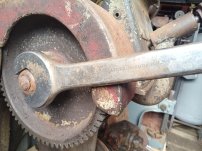
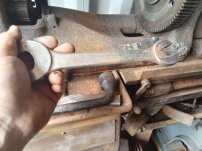
Double end wrench with 'Flather Nashua N.H.' stamped into it, and sized to fit several adjusting bolts on this lathe.


dundeeshopnut
Hot Rolled
- Joined
- Mar 27, 2020
I hear ya. Spend more than anybody in their right mind [that train left me at the station a long time ago] for a machine's jewelry and accessories than the girl's worth.
Similar threads
- Replies
- 26
- Views
- 1K
- Replies
- 7
- Views
- 574



